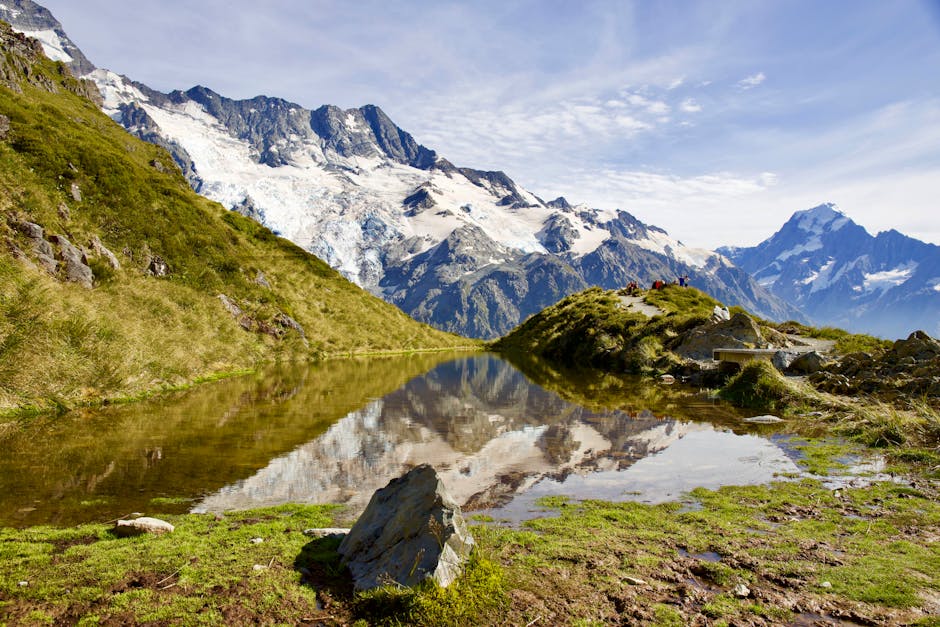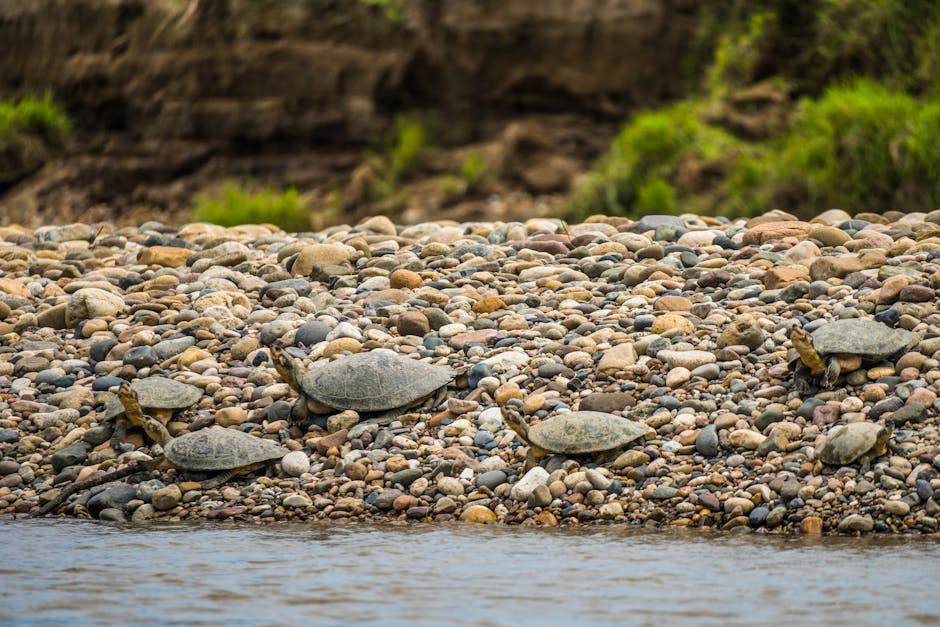A recent report indicates that only 2% of New Zealand’s large lakes are in good health, most rivers have health and poison warnings - New Zealand Rivers And Lakes are Filled With Poison
New Zealand is renowned for its stunning landscapes, pristine environment, and breathtaking rivers and lakes. However, this once-idyllic image is now marred by a grim reality - many of these water bodies are contaminated and filled with poison. The pollution of New Zealand's rivers and lakes has become a pressing concern that demands immediate attention.
Over the years, various pollutants such as agricultural runoff, industrial waste, and urban development have taken a toll on these water resources. Pesticides, fertilizers, and other chemicals used extensively in agriculture seep into the soil and find their way into rivers and lakes through surface runoff, negatively impacting the water quality. The discharge of untreated wastewater from industries and urban areas further exacerbates the problem, releasing harmful substances and toxins into the ecosystems.
The consequences of this contamination are far-reaching. Not only does it endanger aquatic life, but it also poses a significant threat to human health. The presence of pollutants like e.coli and toxins in the water can lead to waterborne diseases, making the water unfit for recreational activities such as swimming and boating. Moreover, the degradation of these natural habitats disrupts delicate ecosystems, affecting the biodiversity and ecological balance.
Efforts to address this issue have been initiated by the New Zealand government and environmental organizations. Legislation has been introduced to regulate the use of agricultural chemicals and to promote the adoption of sustainable farming practices. Collaborative efforts between industries and community groups have been established to mitigate the pollution caused by industrial and urban activities. However, despite these initiatives, progress has been slow, and the health of the country's rivers and lakes continues to deteriorate.
In this blog post, we delve deeper into the critical issue of New Zealand's poisoned rivers and lakes. We examine the causes, consequences, and ongoing efforts to combat this pollution. By raising awareness and discussing potential solutions, we hope to inspire individuals, businesses, and policymakers to take action and collectively work towards a cleaner and healthier environment.
Stay tuned for the upcoming sections where we explore the impact of pollution on wildlife, the challenges faced in restoration, and innovative solutions being implemented to address this pressing environmental crisis.
Explanation of the main causes of water pollution in New Zealand (agricultural runoff, industrial waste, and wastewater)

New Zealand Rivers and Lakes Filled With Poison
Water pollution is a grave environmental concern in New Zealand, with its pristine rivers and lakes facing significant degradation due to various causes. Understanding the main factors contributing to this issue is crucial for implementing effective solutions. In this section, we will delve into three key causes of water pollution in New Zealand: agricultural runoff, industrial waste, and wastewater.
1. Agricultural Runoff: New Zealand's thriving agricultural sector, known for its dairy and meat production, plays a significant role in the nation's economy. However, intensive farming practices coupled with excessive use of fertilizers and pesticides have led to a concerning problem of agricultural runoff. When it rains, these chemicals and nutrients are washed off from farms into nearby water bodies, contaminating them. Excessive nutrients like nitrogen and phosphorus can trigger harmful algal blooms, depleting oxygen levels in the water and suffocating aquatic life.
2. Industrial Waste: Industrial activities, including manufacturing processes and mining operations, contribute to water pollution in New Zealand. Disposal of hazardous substances, untreated wastewater, and improper waste management practices can result in toxic contaminants finding their way into rivers and lakes. Such pollutants, like heavy metals, chemicals, and oils, pose a significant threat to the health of aquatic ecosystems and the species that rely on them.
3. Wastewater: Urban centers generate substantial amounts of wastewater from households, commercial establishments, and industries. While many cities have wastewater treatment facilities in place, older infrastructure or discharges from illegal connections can still release untreated or partially treated sewage into waterways. This untreated wastewater carries harmful pathogens, viruses, and pollutants, putting the integrity of New Zealand's water sources at risk.
Addressing these causes of water pollution requires collective effort from various stakeholders. The New Zealand government, in collaboration with industries, agricultural entities, and local communities, is working towards implementing regulations and best practices to mitigate pollution. Improved farming techniques, adoption of sustainable production methods, and stricter monitoring systems are being encouraged to reduce agricultural runoff. Similarly, industries are being held accountable for preventing the release of harmful waste into water bodies through stringent regulations and regular inspections. Upgrading wastewater treatment plants and promoting responsible waste disposal practices in urban areas is also crucial for safeguarding New Zealand's water resources.
By tackling these causes head-on and promoting sustainable practices, we can contribute to the restoration and preservation of New Zealand's once-pristine rivers and lakes. Protecting the quality of our water not only benefits the environment but also ensures the availability of safe drinking water and sustains the biodiversity that relies on these invaluable ecosystems.
Overview of the harmful effects of water pollution on aquatic life and ecosystem balance

Water pollution poses a significant threat to the delicate balance of aquatic life and ecosystem health in New Zealand's rivers and lakes. The harmful effects of this pollution can have far-reaching consequences for both the environment and human health.
Firstly, the introduction of pollutants into water bodies can lead to devastating impacts on the survival and reproduction of aquatic species. Industrial waste, agricultural runoff, and improper disposal of chemicals contribute to the contamination of water sources, causing toxic substances to accumulate. For example, heavy metals, such as lead and mercury, can accumulate in the tissues of fish and other aquatic organisms, posing serious health risks to both the wildlife and humans who rely on these water resources.
Water pollution also disrupts the ecological balance of rivers and lakes. Excessive nutrient loading, often caused by agricultural practices and sewage discharge, can result in an overgrowth of algae. This process, known as eutrophication, depletes oxygen levels in the water, leading to the creation of dead zones where aquatic organisms cannot survive. Consequently, native species decline, and the biodiversity of the aquatic ecosystem is compromised. Furthermore, the presence of pollutants in the water can alter the natural composition of the ecosystem, favoring the growth of invasive species that can outcompete and displace native organisms.
The negative impacts of water pollution extend beyond aquatic life, affecting the overall health and well-being of communities that rely on these water sources. Contaminated water can pose a significant risk to human health, as it may contain harmful bacteria, viruses, and parasites that can cause waterborne diseases. Additionally, the consumption of fish and other aquatic organisms contaminated with pollutants can lead to long-term health problems, including organ damage and increased risk of cancer.
Addressing water pollution requires a multi-faceted approach that involves government regulations, industry practices, and public awareness. Stricter discharge standards and improved wastewater treatment systems are necessary to prevent the release of harmful substances into water sources. Additionally, promoting sustainable agriculture practices and responsible waste management can help reduce the amount of pollutants entering rivers and lakes. Increasing public awareness about the detrimental effects of water pollution and encouraging individual actions, such as reducing the use of chemical pollutants and properly disposing of waste, also play a crucial role in preserving the health and vitality of New Zealand's rivers and lakes.
In conclusion, water pollution poses a severe threat to the fragile balance of aquatic life and ecosystem health in New Zealand's rivers and lakes. The detrimental effects extend beyond the environment, impacting human health and the overall well-being of communities. It is imperative that we take collective action to address this issue, implementing stringent regulations, promoting sustainable practices, and fostering awareness to safeguard the invaluable water resources of New Zealand.
Examination of the impacts of poisoned waterways on public health and recreational activities (e.g., swimming, fishing, and boating)

New Zealand Rivers and Lakes Filled With Poison: Examination of the impacts of poisoned waterways on public health and recreational activities
New Zealand, known for its stunning landscapes and pristine natural beauty, is facing a grave environmental crisis. A significant number of its rivers and lakes have become contaminated with toxic pollutants, posing serious risks to public health and disrupting popular recreational activities.
The consequences of poisoned waterways on public health cannot be ignored. The contamination of these natural water sources puts the well-being of individuals and communities at stake. Toxic substances, such as nitrates, pesticides, and heavy metals, can enter the water system through agricultural runoff, industrial pollution, and inadequate wastewater management. When consumed or exposed to these pollutants, people may experience various health issues, including gastrointestinal problems, respiratory disorders, and even long-term chronic diseases.
Apart from the direct impact on public health, the pollution of rivers and lakes also poses a threat to recreational activities enjoyed by both locals and tourists. Swimming, once a favored pastime in these picturesque water bodies, has become a risky endeavor due to the presence of harmful bacteria and toxic chemicals. Fish populations have suffered greatly, with an increasing number of species dying off or becoming unsafe for consumption. This has greatly affected the fishing industry, as well as the recreational joy of angling. Boating enthusiasts also face challenges as polluted waterways mean certain areas need to be avoided altogether, limiting their options for exploration and enjoyment.
The implications of poisoned waterways go beyond immediate health concerns and economic impacts. They deeply affect the overall perception and image of New Zealand as a clean, green, and environmentally responsible country. The degradation of its natural assets raises questions about sustainable practices, regulations, and the accountability of various industries operating within the nation.
Addressing this issue requires a multi-faceted approach involving collaboration between government bodies, industries, and the public. Implementing stricter regulations and monitoring systems for industrial activities and agriculture is crucial. Alongside this, investing in sustainable farming practices, improving wastewater treatment facilities, and promoting education about the importance of protecting water sources can aid in preventing further contamination.
Ultimately, the restoration and preservation of New Zealand's rivers and lakes should be a top priority for the nation. By taking immediate action to tackle the sources of pollution and implementing effective solutions, we can safeguard public health, revive recreational activities, and preserve the reputation of this beautiful land for future generations to enjoy.
Discussion of the role of government regulations and environmental policies in preventing water pollution

Water pollution is a pressing concern that requires urgent attention and action. The role of government regulations and environmental policies in preventing water pollution cannot be overstated. In New Zealand, the alarming state of rivers and lakes has been a cause for concern among environmentalists and the public alike.
Robust government regulations play a vital role in safeguarding our water bodies. These regulations ensure the enforcement of strict standards for industries and individuals when it comes to disposing of waste and contaminants. By setting limits on the amount of pollutants allowed in water bodies and mandating regular monitoring, governments can effectively mitigate the risk of water pollution. Additionally, these regulations serve as a deterrent, discouraging individuals and industries from engaging in practices that may harm the environment.
Environmental policies are another crucial component in protecting our rivers and lakes. These policies aim to strike a delicate balance between economic growth and ecological sustainability. By focusing on sustainable development, the government can encourage business practices that reduce water pollution. Incentives or tax breaks can be offered to companies that adopt environmentally friendly technologies and practices, further encouraging responsible behavior.
To ensure the effectiveness of such regulations and policies, thorough monitoring and strict enforcement must be in place. Regular inspections, both announced and surprise, can help identify potential polluters and hold them accountable for their actions. Proper penalties and fines should also be in place for those found in violation of the regulations, serving as a deterrent to others who may be tempted to pollute our waterways.
Moreover, the government should actively engage with stakeholder groups, including environmental organizations, local communities, and industry leaders, to gather insights and feedback. Collaboration and open dialogue can lead to the formulation of more effective policies, taking into account both the economic and ecological aspects of water management.
However, government regulations and policies alone are not enough to solve the water pollution crisis. It is crucial for individuals to play their part as well. Raising awareness about the importance of water conservation and encouraging responsible water usage can go a long way in safeguarding our rivers and lakes. By promoting a culture of sustainability and personal responsibility, we can collectively make a significant impact on reducing water pollution.
In conclusion, government regulations and environmental policies play a critical role in preventing water pollution in New Zealand. By implementing stringent standards, providing incentives for sustainable practices, and enforcing penalties for violators, governments can create a framework that promotes responsible behavior. Nevertheless, it remains essential for individuals to understand their role and actively participate in preserving the purity of our water bodies. Only through a combined effort can we hope to restore and protect our rivers and lakes for generations to come.
Analysis of the current state of New Zealand's water quality and the extent of contamination in its rivers and lakes

New Zealand's pristine reputation for its picturesque landscapes, including its crystal-clear rivers and lakes, is at risk due to a grave concern – pollution and contamination. A comprehensive analysis of the current state of water quality in New Zealand reveals a startling truth; many of its rivers and lakes are filled with poison.
The extent of contamination in New Zealand's waterways is alarming. Various pollutants such as industrial waste, chemical runoff from farms, and domestic sewage have contributed to the degradation of water quality. The environmental impact of these contaminants is devastating, not only for the ecosystems that rely on these water sources but also for the communities that depend on them for their livelihoods.
Research conducted by reputable organizations, such as the Environmental Protection Agency, indicates that only 28% of New Zealand's rivers and 13% of its lakes meet the country's water quality standards. This shocking statistic underscores the urgent need for action and highlights the significant extent of the problem at hand.
Contaminated water sources have severe implications for both human and aquatic life. It poses a serious threat to biodiversity, impacting fish populations, marine mammals, and native species that depend on these water bodies for survival. Furthermore, polluted water presents an imminent risk to public health, as it can lead to the spread of waterborne diseases and pose a substantial risk to those who rely on these water sources for recreation or drinking water.
The causes of this pollution are multi-faceted and demand a holistic solution. The intensification of agricultural practices, inadequate treatment of wastewater, and inadequate management of industrial waste are some of the key contributors. Additionally, urbanization and population growth also play a role in exacerbating the issue.
Addressing this problem requires a collaborative effort from various stakeholders, including government bodies, businesses, and communities. Stricter regulations on waste disposal and agricultural practices, improved wastewater treatment systems, and increased public awareness are just a few of the steps that can be taken to combat this issue and preserve New Zealand's precious water resources.
Considering the significant economic impact of New Zealand's thriving tourism industry, it is crucial to address this issue swiftly and decisively. The degradation of water quality not only tarnishes the reputation of the country but also undermines the potential for sustainable growth and development.
As environmentally conscious citizens, it is our responsibility to take action and demand change. By advocating for stricter regulations, supporting organizations working towards water quality improvement, and adopting sustainable practices in our everyday lives, we can contribute to the restoration and protection of New Zealand's rivers and lakes.
New Zealand's rivers and lakes are a vital part of its identity, and their well-being should be a top priority for all those who care about the country's natural heritage. By working together, we can ensure a healthier and more sustainable future for these precious water bodies, leaving a positive legacy for generations to come.
Exploration of the efforts and initiatives taken by organizations and communities to address the issue of poisoned waterways

In response to the alarming state of New Zealand's rivers and lakes, numerous organizations and communities have come forward to address the pressing issue of poisoned waterways. These dedicated and passionate groups have taken on the challenge of exploring innovative solutions while raising awareness about the detrimental effects of pollution on our natural resources.
One initiative that has gained significant momentum is the restoration of riparian zones. Riparian zones act as a buffer between land and water, playing a crucial role in filtering pollutants and preventing them from reaching our rivers and lakes. Many environmental organizations have been actively working to replant native vegetation along waterways, which helps stabilize the banks, filter out sediment, and absorb excess nutrients and pesticides before they enter the water. By investing in riparian restoration projects, these organizations aim to improve water quality and create healthier ecosystems for aquatic life.
Additionally, several communities have organized regular cleanup campaigns to remove rubbish and debris from water bodies. Led by local volunteers, these efforts serve as a powerful reminder of the collective responsibility we hold in preserving the environment. Through community engagement and educational programs, these cleanups not only contribute to the physical improvement of waterways but also raise awareness about the impact of human activities on our natural resources. By inspiring individuals to take action and make sustainable choices, these initiatives foster a sense of ownership and responsibility for the health of our rivers and lakes.
Partnerships between farmers and environmental organizations have also emerged as a significant driving force behind the restoration of New Zealand's waterways. Recognizing the potential impact of agricultural run-off on water quality, many farmers have embraced sustainable farming practices that seek to minimize chemical use, adopt responsible irrigation techniques, and manage livestock waste effectively. Collaborative efforts between farmers and environmental groups have resulted in the implementation of best management practices, such as fencing off waterways and utilizing riparian planting, to reduce the impact of farming activities on water quality. These partnerships demonstrate that a balance can be achieved between agricultural productivity and environmental preservation.
To further raise awareness about the issue, documentaries, public forums, and online campaigns have shed light on the urgent need for collective action. These platforms provide a space for dialogue, information sharing, and advocacy, helping to mobilize individuals and communities to actively participate in the preservation of our waterways. As public awareness continues to grow, the pressure on policymakers and governing bodies to prioritize and invest in long-term solutions also intensifies.
In the face of the daunting challenge presented by poisoned waterways in New Zealand, it is heartening to witness the dedication and progress made by organizations, communities, and individuals working towards their restoration. Through a combination of riparian restoration, community cleanups, sustainable farming practices, and effective collaboration, positive steps are being taken to safeguard the health and integrity of our rivers and lakes. These efforts must continue to ensure a thriving ecosystem for present and future generations.
Examination of the importance of raising public awareness and fostering sustainable practices to combat water pollution

Water pollution is a grave concern that has been plaguing New Zealand's rivers and lakes for far too long. The alarming levels of contamination, filled with poisonous substances, raise a pressing need for immediate action. One crucial aspect in tackling this issue is raising public awareness about the severity of water pollution and the potential consequences it poses to not only the environment but also to our own health and wellbeing.
By educating the public on the detrimental effects of water pollution, we can instill a sense of urgency, prompting individuals to take action and make informed choices regarding their own practices. Highlighting the direct correlation between polluted water sources and negative impacts on aquatic life, ecosystems, and even human consumption, we can emphasize the importance of preserving these precious resources for future generations.
Public awareness campaigns should target both individuals and businesses, as collective efforts are required to combat water pollution effectively. Emphasizing the role of sustainable practices is key. Encouraging responsible waste disposal, promoting the use of biodegradable products, and raising awareness about the harmful effects of certain industrial processes on water quality can make a significant difference.
Furthermore, fostering sustainable practices within industries that contribute to water pollution is vital. Implementing stricter regulations and incentivizing businesses to adopt eco-friendly practices can help reduce their environmental footprint. This includes monitoring and controlling industrial waste discharge, promoting water-saving technologies, and encouraging the use of renewable energy sources.
Collaboration between government entities, environmental organizations, and local communities is essential in implementing effective measures to combat water pollution. Public engagement through community initiatives, such as river and lake clean-up drives, can create a sense of ownership and responsibility for protecting these precious water bodies. Encouraging citizen science programs and involving schools in educational projects can also foster a culture of environmental stewardship from an early age.
It is imperative that we prioritize the restoration and preservation of New Zealand's rivers and lakes. This requires a collective effort to raise public awareness about water pollution and its long-term consequences. By promoting sustainable practices and engaging communities in the protection of our natural water resources, we can work towards a cleaner, healthier future for all.
Discussion on the significance of river and lake restoration projects in New Zealand and their potential outcomes

New Zealand is renowned for its pristine natural beauty, boasting picturesque rivers and lakes that have long been an integral part of its identity. However, recent studies have unveiled the alarming truth that many of these water bodies are contaminated with harmful toxins. This dire situation calls for immediate action, with restoration projects emerging as a crucial solution to reverse the damage inflicted upon these crucial natural resources.
The significance of river and lake restoration projects in New Zealand cannot be overstated. Beyond the obvious environmental benefits, such initiatives promote the preservation of precious biodiversity, enhance recreational opportunities, and ensure the sustainability of local communities that depend on these water bodies for tourism and their livelihoods. Moreover, by addressing the contamination issues at their source, these projects also contribute to improving the overall health and wellbeing of New Zealanders.
The potential outcomes of these restoration projects are promising, albeit with considerable efforts required. By implementing effective strategies for water quality management, such as reducing agricultural runoff, limiting pollution from industrial activities, and controlling invasive species, the ecological balance can gradually be restored. As a result, native flora and fauna can thrive in once-contaminated habitats, providing a sanctuary for endangered species and preserving the unique ecological heritage of New Zealand.
Additionally, the restoration of rivers and lakes enhances the overall quality of water resources available for drinking and irrigation purposes. By implementing modern water treatment technologies and promoting responsible water usage, these projects help ensure the availability of clean and safe water for both present and future generations.
However, it is essential to acknowledge that river and lake restoration projects require extensive investment, collaboration, and long-term commitment from all stakeholders involved. Governments, businesses, local communities, and environmental organizations must join forces to provide the necessary resources and expertise for successful outcomes. Furthermore, raising awareness among the public regarding the importance of water conservation and the detrimental effects of pollution is crucial to achieving lasting change.
In conclusion, the deteriorating state of rivers and lakes in New Zealand demands urgent attention. Through dedicated restoration projects, we can reverse the damage inflicted upon these vital water bodies. By promoting sustainable practices, investing in innovative technologies, and fostering partnerships, we have the opportunity to preserve the natural beauty of New Zealand for future generations. Let us take action now to ensure the revival and protection of these once-pristine rivers and lakes, reclaiming their significance as symbols of clean and healthy ecosystems.